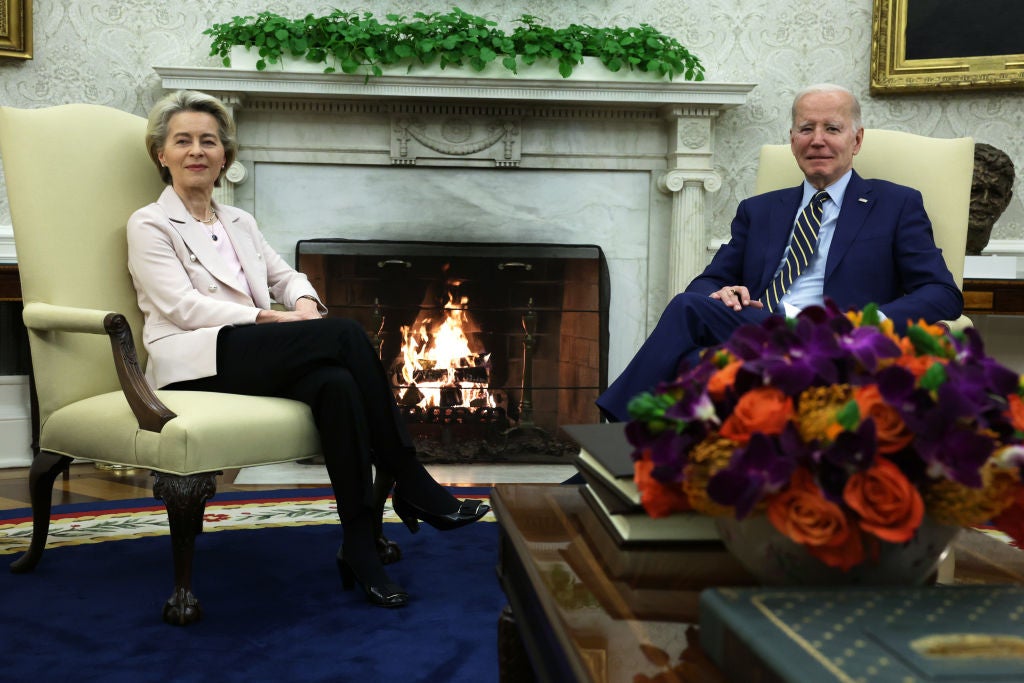Two hallmark accomplishments of the Biden administration are: passing historic climate legislation and shoring up cross-Atlantic solidarity in the wake of Russia’s invasion of Ukraine. President Joe Biden would do well to build on these areas of progress and strike a deal with the EU on climate and trade, enhancing coordination between two of the world’s largest economic centres. A deal would allow both regions to reap the benefits of faster and more efficient decarbonisation, while boosting job creation and strengthening supply chains.
Europe’s reception of US moves to advance climate and clean energy priorities to the benefit of US companies – through the Inflation Reduction Act, CHIPs and Science Act and Buy Clean provisions for government procurement – has not been entirely welcoming. In early March, President Biden and European Commission President Ursula von der Leyen met to discuss the green industrial policy dispute triggered by this suite of US policies. At the same time, the EU is moving ahead with the world’s first carbon tax on certain imports, the EU Carbon Border Adjustment Mechanism (CBAM). The measure, which passed its last hurdle on 25 April and will start its pilot phase this October, will affect US companies exporting covered goods to the EU.
This is not the first time the US and the EU have been at odds over economic or trade policy, and it won’t be the last. However, the economic opportunities from cooperation on climate and trade far outweigh the transaction costs.
Here’s how it could work. The transatlantic deal on climate and trade should have the ability to grow and adapt, similar to the climate, trade and sustainability “living agreement” planned between Costa Rica, Fiji, Iceland, New Zealand and Norway which allows countries to put forward other issues for consideration over time. That way, an agreement can start quickly, covering specific sectors or products, and then expand. The goal is to create space for policymakers to try new things to cut greenhouse gas emissions while keeping industries from relocating to regions with laxer pollution guidelines.
Keep up with Energy Monitor: Subscribe to our weekly newsletterFirst, the US and EU need to agree on some general principles. Guiding rules may include that each country chooses its own pathway towards decarbonisation; that each may decide how to address the carbon pollution emitted to produce imported goods; and that the two economic blocs treat each other as partners on climate and trade, including sharing market access, to create a joint market for cleantech.
The scope of the deal should evolve as the field of climate and trade measures matures over time. To play fair, the EU and US would have to share data and ensure transparency on green subsidies and other support measures; support cleantech industries with subsidies for specific sectors; build sustainable and resilient supply chains, both domestically and abroad, with a view to critical raw materials, human rights and labour provisions; and limit the risk of losing businesses to less climate-ambitious economies while limiting the import of products made in highly climate-polluting factories.

US Tariffs are shifting - will you react or anticipate?
Don’t let policy changes catch you off guard. Stay proactive with real-time data and expert analysis.
By GlobalDataBoth the US and EU need to make sure cleantech industries are set up to succeed – they can support them by steering government purchases towards these low-carbon products, by removing regulatory barriers to the uptake and trade of cleaner products, and by aligning standards for measuring the production-related emissions in imported goods. An example of ongoing negotiations to promote the greening of two sectors is the US-EU Global Arrangement on Sustainable Steel and Aluminium, expected to be finalised this October, which will set tariffs based on how much carbon the producing country’s industry generates to encourage low-emissions methods.
Fortunately, the right places to hammer out the details and build this US-EU alignment already exist. The details of the agreement can be developed within the new Transatlantic Initiative for Sustainable Trade and the new Clean Energy Incentives Dialogue of the US-EU Trade and Technology Council. Since the deal should be a living document, the US and EU should check in periodically to ensure that the agreement still supports each region’s growing clean energy economy and that it moves both towards their climate goals. Therefore, the agreement needs to be equipped from the start, with a permanent secretariat and staff.
Signalling that the EU and US can cooperate on climate and trade will have massive impacts across the globe, since this will be the standard and blueprint for others to follow. The EU and US together form the largest economic area in the world, and both are well positioned to begin negotiating a plurilateral climate and trade agreement, having adopted ambitious climate measures.
There is significant alignment between the US and the EU on the general direction of travel, towards full decarbonisation by 2050, and a reasonable expectation to coordinate steps towards this target, minimising bumps on the road. The meeting between Biden and von der Leyen was a start, but more is needed, and the two regions’ leaders should take advantage of meetings such as the next EU-US summit in October. The global race towards clean energy is off and running – to give their economies the best chance of succeeding, the US and EU would be wise to work together.






